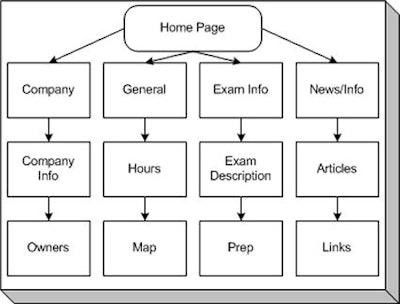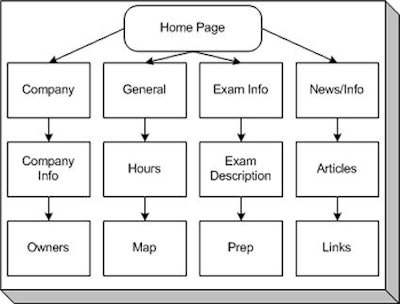
REA Healthcare Strategies

Still others feel that without the Web, there is great potential for losing valuable business. Deciding whether there is a need to have a product on the Web is definitely the first and most critical step. It is also necessary to answer some fundamental questions before proceeding with the project planning:
- Who will the users of your e-product be?
- Will this product give your medical practice a competitive advantage?
- Is there business to be gained because you have a Web site?
- Will this product provide your clients (patients, medical community, payers, suppliers, etc.) with a valuable resource?
- Does the local market need to be educated on your specialty?
- Will communication be bidirectional, and will you have the opportunity to gain feedback from your clients through your product?
- Can you improve your communication or relationships with your clients through this product?
- Do you have the resources necessary to develop, implement, and maintain your product (money, staffing, necessary hardware, Web designers, etc.)?
- How will you market your product?
- Who will develop the content? (physicians, administrators, technologists, nurses, etc.)
- Does your practice need to integrate information systems to create a fluid product for your clients?
With careful management of each component, developing a Web site does not have to be overwhelming.
Identifying users
Identifying who will use the Web site defines the scope of the audience and the direction of the content. It is also essential to define potential clients that the practice hopes to gain or reach with a Web site.
Remember that this product will open the doors to a worldwide market, which widens the scope of information needed. For example, will the users primarily be patients inquiring about their future exams and reports, or will the referring community, payors, and other clients actively use the product?
Or are you aiming to introduce the practice to an international market? If so, offering content in other languages, or offering content that’s valuable to specialized markets, may accomplish those strategic goals (for more information, see Developing and Deploying a Web Site by Todd Burgess).
If the purpose of the product is to meet the needs of local patients and referrers, users may expect to access confidential patient information, schedule or request appointments online, view exams, or view billing information. Bidirectional communication is necessary.
The development team needs to consider whether additional databases will require interfacing with the Web site. Necessary mechanisms to interface and update critical operational information will require the expertise of Web designers and information systems personnel.
After identifying each user group, define the information that each distinct group will access. This will be critical for developing Web site security and client access parameters.
Referring physicians and their key staff members will need to have login and password designations to allow access to certain segments of information. As the Health Insurance Portability and Accountability Act (HIPAA) finalizes regulatory policy with regards to this area, compliance with this component will require documentation and adherence.
Creating a site map
Begin to map out the components of the Web site. This exercise will provide a visual assessment of the information segments needed for each user group. Identify and map future development areas as well. Start with the home page and branch out from there. Keep it simple. As segments are added, this foundation will be very useful for placing the new areas. Below is an example of a Web site map.

If an outside agency is utilized for the design and presentation, this map will be necessary to guide their work.
Identify required resources
There are three key resources that need to be identified in the initial phases of the Web site project:
- Experts, either in-house or from an outside agency, who will develop the content of the Web product.
- Web designers who will develop the presentation and layout.
- An Internet service provider (ISP) for hosting the Web site or in-house servers hosting the site.
Content developers are needed to produce the information that appears on the site. Ideally, at least one of the developers is a physician, nurse, or a technical/clinical individual who understands medical procedures and can discuss them in simple terms. There should also be individuals who will author the service-related topics such as hours, scheduling, and insurance information. After the Web site map is completed and the subsections identified, you'll have a better understanding of what content is needed.
A structured format will help in laying out the information for each department. The format should be easy to follow, and make it easy for a user to find key information points. Do not allow the content to get too technical.
Think like a patient, who may be using the site strictly for education about their specific exam. You'll need to maintain interest and be informative. When including images to identify specific exams, use anatomical identifiers for clarity. If in-house experts are not available, using an outside agency will be necessary. Assign one individual or a small team of individuals to work with the agency to keep the content accurate.
Web designers will take the medical information and create an attractive layout. Again, keep the layout simple. Do not allow the process of maneuvering through the information to become complex. A user will get bored and leave the Web site if it is too difficult to find key information. Look at a Web designer’s portfolio and call references. Establish timetables for each segment and overall completion time.
Access groups
For control purposes, each user group should be segmented on the basis of data requirements. There are internal users (intranet), which are members of your facility utilizing the network for operational purposes. There is also an external group (extranet) that will access very specific information from or through the Web site (such as referring offices), and then there is the public, which will have general access to the site.
The facility’s information technology team should establish access to confidential information through passwords. If databases will be interfaced with the Web site, it will be critical to work closely with the software vendors of each database to synchronize access to specific data components.
Content
Web-based content should be kept simple and informative. Each user will access the site for very specific information. Direct the content to the users in an easy-to-follow format. The content should be pertinent, simple and easy to read. Have detail-oriented editors review all information.
Use marketing personnel to evaluate material for its descriptiveness and market appeal. Although content should be medically accurate, there are ways of presenting dull information in a very interesting manner. If the content developers are very clinical, have someone else inject some life into the copy. The Web site is an avenue to reach a new audience and clients, and will serve as a tool to increase your client base. The marketing value of your site should always be kept in mind during the development process.
To host or not to host
If your facility has the hardware, financial means, and expertise to set up a Web server, then the practice can maintain control over the server internally. Otherwise, outsourcing this component is a common practice. There are many ISPs that will host a Web site very economically. These providers will set up virtual hosting (several businesses are directed to the same server).
One of the advantages of using an ISP is that the firm can expand services to accommodate increased demand on the Web site. An ISP can also help coordinate information needed by the Web designers, such as acquiring a Uniform Resource Locator (URL) and providing host name, server information, and passwords. For the most part, the practice’s administrator will maintain security on the network and will work closely with the ISP for technical issues.
Marketing the finished product
Once the work of art has been created, do not let it sit unnoticed. Place your URL on all printed materials that the practice distributes. Create a pleasant on-hold phone message with the Web site information on it. Every referral pad, address sticker, letter, and newsletter should announce the site. Inform your potential users about the information available to them.
By Elsa Ozuna-RichardsAuntMinnie.com contributing writer
December 23, 2002
REA Healthcare Strategies is a consulting firm focusing on healthcare marketing and practice management. It specializes in developing marketing programs for practices and vendors. It also has extensive experience in providing medical practices with strategic planning, project management, and customer-service training programs.
Related Reading
Patient-oriented MRI Web sites don't tell the whole story, December 11, 2002
Customer service begins at the top, November 22, 2002
Building a successful new imaging center program, October 8, 2002
Imaging center marketing: Don't trade dollars for doughnuts, September 18, 2002
Copyright © 2002 REA Healthcare Strategies



















